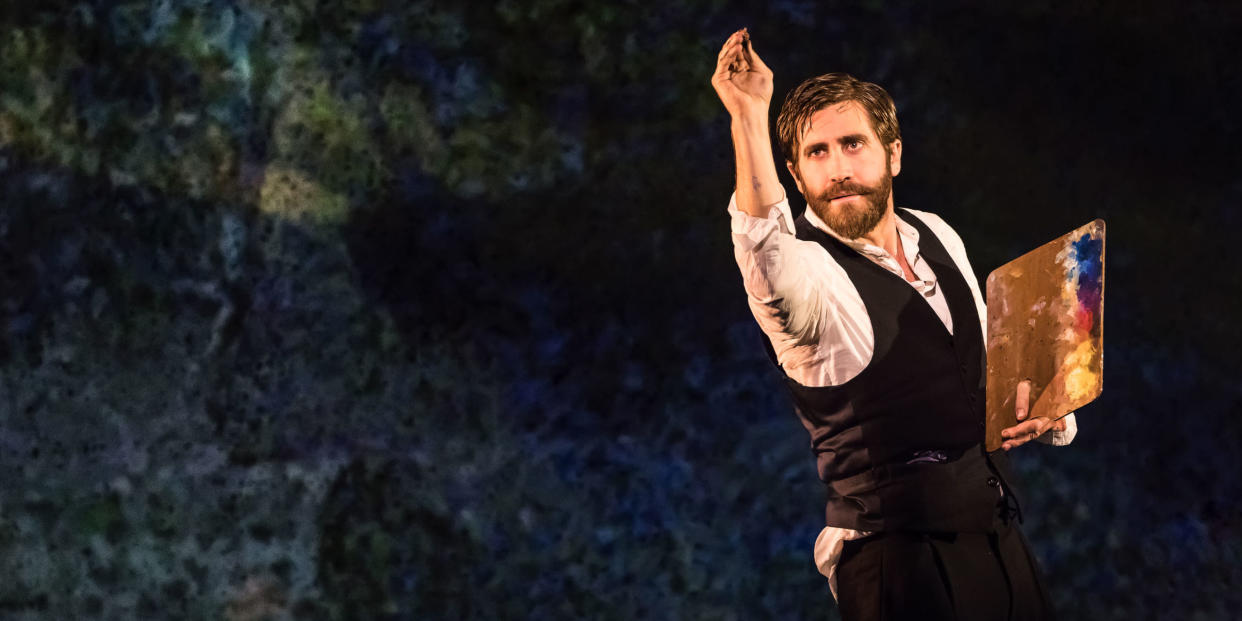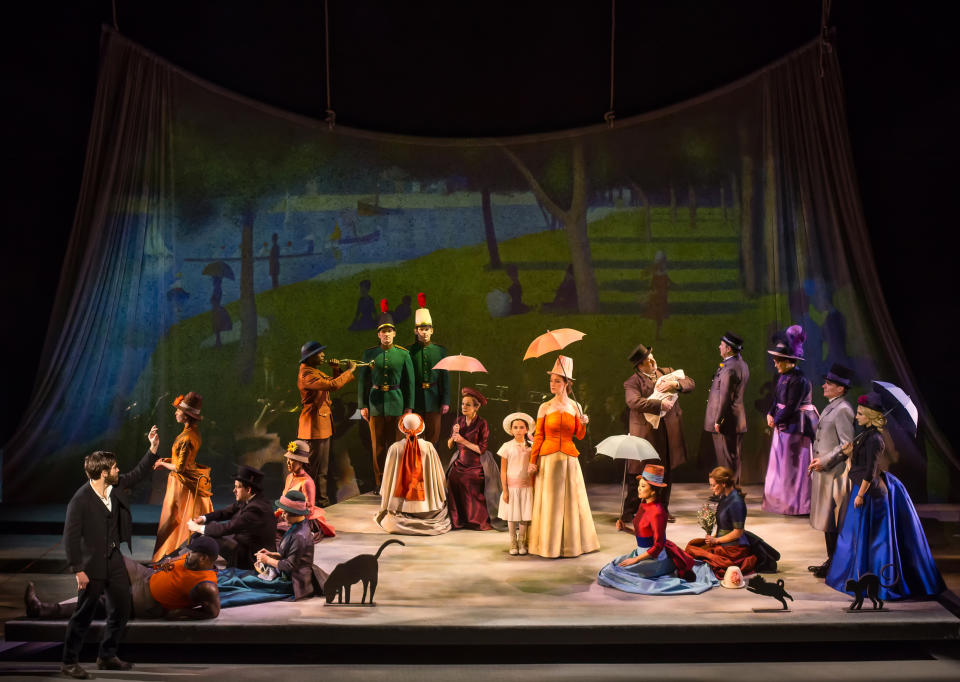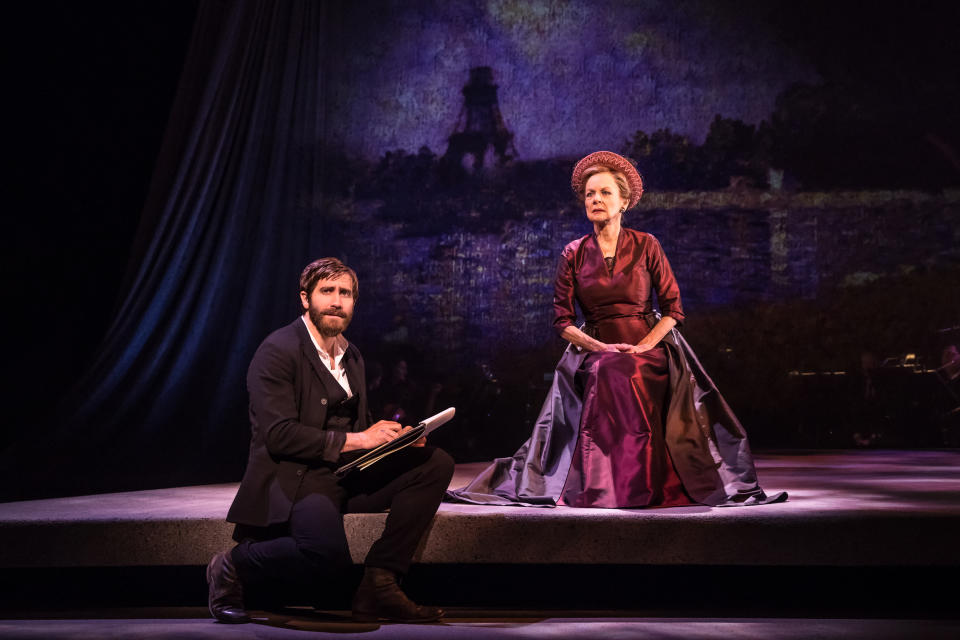Jake Gyllenhaal Proves He Can Really, Truly Sing in 'Sunday in the Park with George'

The reason they're lining up to get into Sunday in the Park with George, arguably the quintessential Stephen Sondheim musical, isn't so much the musical as its star, the thinking man's movie hunk Jake Gyllenhaal. The good news is that Gyllenhaal, as the moody pointillist Georges Seurat, is outstanding. The even better news is that he's at best the third most compelling thing on stage.
It wouldn't sell tickets, but top billing should arguably go to the Chromolume. And the most striking performance in this revival, which opened tonight at the newly resurrected Hudson Theatre, comes from Annaleigh Ashford, as Georges's neglected lover, Dot.
The good news is that Gyllenhaal is outstanding.
We know Gyllenhaal can act. The real question was whether he could sing. He brought the house down in the City Center Encores revival of Little Shop of Horrors two summers ago, but that was more for his winsome performance than his vocal chops. When Sunday came to Encores last summer, he was in better voice but still no musical star. Here, he sounds great-he's been taking lessons, clearly-with a full and clear tenor that, combined with his usual introspective charm and rugged good looks makes him a stellar Georges.

As good as he is, though, it's Ashford who most deeply impressed. She's an accomplished performer, a Tony winner, but her big roles thus far have been comic ones: an acrobatic ditz in You Can't Take It With You and an overactive pup in Sylvia. So it's a very welcome surprise to find her Dot to be such a fully formed character, stronger and smarter than I've previously thought of the role.
Dot's fortitude is telegraphed from the first moments, as she models for Georges and wryly complains of its unpleasantness, though her late Act One tour de force, "I Have to Move On," when she gathers the courage to leave her true love. Art is about, among other things, tension, balance, and harmony, Georges says, and Gyllenhaal and Ashford are tense, balanced, and harmonic.
But back to the Chromolume. What's a Chromolume, you ask? It's a plot device that has been bedeviling scenic designers since Sunday's Broadway debut, in 1984. The first act of Sondheim and James Lapine's musical follows Seurat as he creates his innovative masterpiece, A Sunday on La Grande Jatte, sacrificing his personal life in his passion for his art, his devotion to capturing color and light. In the second act, Seurat's (fictional) grandson, also George, also an artist, is unveiling his once-innovative work, a laser-light-show contraption he's dubbed a Chromolume.

The 1980s Chromolume, easily viewable on YouTube, is a ridiculous affair that I can only hope was slightly less ridiculous then, essentially Josie and the Pussycats' phallic spaceship places on the Solid Gold stage, with lights and smoke surrounding it. By the 2008 revival, imported from London's Menier Chocolate Factory, the Chromolume was, like everything in Menier production, smaller, and in that case left to be an artifact of another time, a goofy, freestanding laser machine.
Now, finally, the Chromolume makes sense. Sunday's designers have a rigged a system of pulleys over the Hudson's orchestra seats, each with LEDs dangling from a cord. When George displays Chromolume No. 7, the computer-controlled pulleys and LEDs send undulating waves of, yes, color and light, though the auditorium. It's not the most exciting visual art, but it's also, for the first time, a credible stab at what might be real, modern interactive piece. It actually makes sense.
Sunday cannot help feeling like a deeply personal work about the focus and sacrifice required to make great art, the conviction necessary to stand up for new work, and the lasting impact of art.
Otherwise, the staging, by Sarna Lapine (the librettist's niece), is exceedingly straightforward. In Encores style, the orchestra sits upstage, and there is minimal scenery, in this case a scrim in front of the orchestra on which some Grand Jatte backgrounds are projected. There is no coup de scenery, as there often is, in the musical's gorgeous Act One climax, when the Parisians lounging on the Ile de la Grand Jatte arrange themselves into the famous formulation of Seurat's painting as Sondheim's score hits its beautiful harmonic climaxes.

But the material is so strong, and the cast so good, that this Sunday remains deeply affecting. (The supporting cast is filled with often leading performers in small roles, including Brooks Ashmanskas, Ruthie Ann Miles, Robert Sean Leonard, and Jordan Gelber.) Sondheim has often said that he wrote only one autobiographical song, "Opening Doors," about young people starting out, in Merrily We Roll Along.
But Sunday cannot help feeling like a deeply personal work from any artist, especially this one-about the focus and sacrifice required to make great art, the conviction necessary to stand up for new work, and the lasting impact of art. Children and art, they're the things that last, Sunday says, and it says so in a song written by a brilliant artist and gay man who never had children. Like Seurat's painting, it is, and remains, a masterpiece.
Finally, a note on the Hudson: A onetime legitimate theater decommissioned for nearly a half-century, it becomes the 41st Broadway house with this opening. It's a nice if not breathtaking renovation of a glorious old space, and its greatest innovation, under the management of the Ambassador Theatre Group, a British powerhouse, may be that its cocktails are served in real glass barware, not the usual plastic sippy cups. Cheers.
Sunday in the Park with George plays through April 23, 2017 and the newly reopened Hudson Theatre.
You Might Also Like


